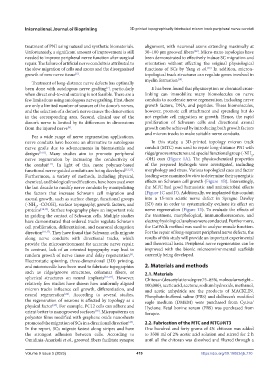Page 427 - IJB-9-5
P. 427
International Journal of Bioprinting 3D printed topographically fabricated micron track peripheral nerve conduit
treatment of PNI using natural and synthetic biomaterials. alignment, with neuronal axons extending maximally at
Unfortunately, a significant amount of improvement is still 30–100 μm grooved fibers . Micro-nano topologies have
[28]
needed to improve peripheral nerve function after surgical been demonstrated to effectively induce SC migration and
repair. The failure of artificial nerve conduits is attributed to orientation without affecting the original physiological
the slow migration of cells and axons and the disorganized functions of SCs by Yang et al. In addition, micron-
[29]
growth of new nerve tissue . topological track structures can regulate genes involved in
[6]
myelin formation .
[30]
Treatment of long-distance nerve defects has optimally
been done with autologous nerve grafting , particularly It has been found that physisorption or chemical cross-
[7]
when direct end-to-end suturing is not feasible. There are a linking can immobilize many biomolecules on nerve
few limitations using autologous nerve grafting. First, there conduits to accelerate nerve regeneration, including nerve
are only a limited number of sources of the donor’s nerves, growth factors, DNA, and peptides. These biomolecules,
and the selection of a donor’s nerve causes the denervation however, promote cell attachment and spreading but do
in the corresponding area. Second, clinical use of the not regulate cell migration or growth. Hence, the rapid
donor’s nerve is limited by its differences in dimensions proliferation of Schwann cells and directional axonal
from the injured nerve . growth can be achieved by introducing both growth factors
[8]
and micron tracks to make suitable nerve conduits.
For a wide range of nerve regeneration applications,
nerve conduits have become an alternative to autologous In this study, a 3D-printed topology micron track
nerve grafts due to advancements in biomaterials and conduit (MTC) was used to repair long-distance PNI with
designs [9,10] . Many studies aim to promote peripheral ridge/groove structures and special functional group (-NH ,
2
nerve regeneration by increasing the conductivity of -OH) cues (Figure 1A). The physicochemical properties
the conduit . In light of this, more polymer-based of the prepared hydrogels were investigated, including
[11]
functional nerve-guided conduits are being developed [12,13] . morphology and stress. Various topological cues and factor
Furthermore, a variety of methods, including physical, loading were examined in vitro to determine their synergistic
chemical, and biological modifications, have been used over effects on Schwann cell growth (Figure 1B). Interestingly,
the last decade to modify nerve conduits by manipulating the MTC had good hemostatic and antimicrobial effects
the factors that increase Schwann cell migration and (Figure 1C and D). Additionally, we implanted this conduit
axonal growth, such as surface charge, functional groups into a 15-mm sciatic nerve defect in Sprague Dawley
(-NH , -COOH), surface topography, growth factors, and (SD) rats in order to systematically evaluate its effect on
2
proteins [14,15] . Surface topography plays an important role nerve regeneration (Figure 1E). To evaluate the effects of
in guiding the contact of Schwann cells. Multiple studies the treatment, morphological, immunofluorescence, and
have demonstrated that ordered tracks regulate Schwann electrophysiological analyses were conducted. Furthermore,
cell proliferation, differentiation, and neuronal elongation the CatWalk method was used to analyze muscle function.
direction [16,17] . They have found that Schwann cells migrate For the repair of long-segment peripheral nerve defects, the
along nerve conduits with directional tracks, which results of this study will provide an important experimental
provide the microenvironment for accurate nerve repair. and theoretical basis. Peripheral nerve regeneration can be
In contrast, lack of an oriented topography may lead to improved with the bionic microenvironmental scaffolds
random growth of nerve tissue and delay regeneration . currently being developed.
[9]
Electrostatic spinning, three-dimensional (3D) printing,
and microneedle have been used to fabricate topographies 2. Materials and methods
such as ridge/groove structures, columnar fibers, or 2.1. Materials
spherical structures on neural implants [18–23] . However, Chitosan (deacetylation degree 75–85%, molecular weight =
relatively few studies have shown how uniformly aligned 100,000), acetic acid, acetone, sodium hydroxide, methanol,
micron tracks influence cell growth, differentiation, and and acetic anhydride are the products of MACKLIN.
neural regeneration . According to several studies, Phosphate-buffered saline (PBS) and dulbecco’s modified
[24]
the regeneration of neurons is affected by topology as a eagle medium (DMEM) were purchased from Cytiva/
physical factor . For example, PC12 cells can adhere and Hyclone. Fetal bovine serum (FBS) was purchased from
[25]
orient better to nanogrooved surfaces . Micropatterns on Serapro.
[26]
polyester films modified with graphene oxide nanosheets
promoted the migration of SCs in a directional direction . 2.2. Fabrication of the MTC and MTC@NT3
[27]
In the report, SCs migrate fastest along stripes and have One hundred and forty grams of 4% chitosan was added
the strongest adhesion between cells. According to to 3500 ml of 2% acetic acid solution and stirred for 2 h
Omidinia-Anarkoli et al., grooved fibers facilitate synapse until all the chitosan was dissolved and filtered through a
Volume 9 Issue 5 (2023) 419 https://doi.org/10.18063/ijb.770

